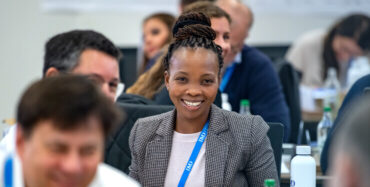
In an era marked by uncertainty, unprecedented disruption, and rapid technological advancements, organizations face a challenging paradox: How can they simultaneously optimize their current operations and prepare for an uncertain future?
Konica Minolta: Investing in infrastructure and people
The powerful legacy business has built its reputation and business around being one of the world’s leading suppliers of business and industrial imaging and printing equipment. However, as the business landscape changed, the organization found a new goal – to tap into the growth possibilities of managed IT and data services, thus helping customers save on operational costs and generate more revenue.
This meant adding new service offerings in the managed IT, data capture, and data management sectors. At the same time, the business had to continue capturing business in the long-established multifunction products and printing devices businesses, which are core markets for the organization. For this dual transformation strategy to succeed, Sam Errigo, Chief Operating Officer at Konica Minolta Business Solutions in the US, decided to invest heavily in infrastructure and talent.
“We opted for a systematic process of infusing talent and new capabilities to help with the transformation across all levels of the business,” Errigo explained. “To do this, we’re making sure that all new hires bring talent into the organization – technologists that can guide customers in a holistic manner.”
“In this way, we ensure the necessary talent and capabilities are in place to both transform our core business and to create new business models and revenue streams for the future.”
Training and education are also provided for existing staff so they can manage both ongoing transformations.
Globe Telecom: Doubling down on customer centricity
In the 14 years since Ernest Cu took over as Globe Telecom’s CEO in 2008, he has successfully transformed Globe from a mobile phone company that was losing market share in the traditional mobile and SMS business into one of the two largest mobile operators and digital payments businesses in the Philippines. To do this, Cu reformed two elements in parallel: transforming its traditional mobile services business while creating a digital services company to serve all Filipinos.
Knowing that Globe was a weaker player in the voice and SMS market and seeing the growing customer preference for smartphones, Globe moved aggressively to overhaul its IT and network capabilities to allow the company to compete in the then-nascent 3G world. Following the network transformation, Globe began layering IT, marketing strategy, and retail transformations onto the roadmap of revolutionizing the nuts and bolts of the business.
At the same time, Cu understood that sustained transformation success required a change in mindset within the company to become more consumer-oriented. To do this, he focused equal efforts on transforming Globe’s internal culture. “We started to create the ‘I Love Globe’ campaign. We started with the employees, engaged them. We worked on making them happy. We improved their benefits and facilities. We ensured that they felt valued and empowered, trying to get them on our journey, to make them passionate about it. It seemed to work.”
Bank Mandiri: Building ambidexterity into organizational DNA
In its quest for regional expansion, Bank Mandiri realized that mere growth was no longer enough. To truly thrive, it needed to tackle two tasks simultaneously: optimize the current business operations and identify new avenues for future growth. This need for dual transformation emerged as the bank grappled with a multifaceted business landscape characterized by shifting consumer behaviors, a competitive digital space, and a mission to uplift traditionally underserved rural areas.
Recognizing the central role of human capital in navigating these challenges, Bank Mandiri’s primary strategy focused on strategic talent development. Their vision was clear: to mold a workforce adept at both maintaining current performance and pioneering future innovations. To do this, the organization partnered with IMD to roll out a learning and development initiative focusing on embedding ambidexterity – the ability to handle paradoxical tasks seamlessly – into the organization’s core.
Through tailored programs, leaders were coached to move beyond traditional roles, embracing innovation, experimentation, and adaptive thinking. Focusing on talent not only aimed to redefine individual skillsets but also sought to equip them with the tools to champion the bank’s dual transformation goals in an ever-evolving business landscape. The result? Senior leaders who participated in the program reported higher confidence in effectively leading the organization through disruptions and challenges.
Regional CEO X (Sulawesi and Maluku) Muhammad Ashidiq said, “Ever since I finished the program eight months ago, my team in eastern Indonesia has worked hard to implement what taught us about leading strategy with “Ambidex” and becoming a transformer.”
“We strive to penetrate the market further, using our core strengths including digital channels.”
Helmy Afrisa Nugroho, Senior Vice President of Corporate Banking, added: “Ambidex inspired our executives to think more systematically about optimizing our current business while pursuing new areas of growth – mainly retail ecosystems and new financing techniques.”
Bank Mandiri has since been ranked among the World’s Best Banks in 2022 by Forbes and made the Top Companies 2022 list. Read Bank Mandiri’s story for an in-depth look at how they successfully transformed the organization while continuing to perform in a complex business landscape. Download the story.


